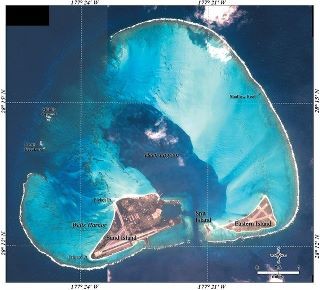
Low-lying Midway Atoll (Sand Island left, Eastern Island right) is at risk to being overwashed by tsunamis
ACAP Latest News reported last month on the tsunami that reached both Kure and Midway Atills in the Northwestern Hawaiian Islands following an earthquake on 29 July 2025. News is now in from the U.S. Fish and Wildlife Service on the impact of the tsunami on Midway’s biota, including its Laysan Albatrosses, Phoebastria immutabilis, which seem have largely escaped harm. Nearly all the Black-footed Albatross P. nigripes chicks had fledged prior to the tsunami.
A few days after the tsunami waves hit Midway, the staff conducted post-tsunami assessments of Sand Island and Eastern Island. The below summary details observations of the tsunami impacts.
Sand Island:
- Limited overwash occurred on Sand Island, the dunes on North Beach were hardly impacted. There was no evidence of overwash into the vegetation along West Beach, and minimal intrusion into Rusty Bucket area was found.
- Beaches that often have been found to shift in extent and shape after storms seemed largely unchanged across Sand Island.
Eastern Island:
- Eastern and Spit presented more significant evidence of overwash leading to impacts to wildlife and habitat with water extending inland up to 150 ft, though the vast majority of shoreline presented intrusion of 50 ft or less.
- The heavily vegetated isthmus between Split and Eastern Island did not wash over, sparing the thousands of sooty tern chicks present there at the time.
- Water still moved through stands of coastal vegetation with enough energy to dislodge and concentrate groundcover vegetation, primarily alena (Boerhavia repens), mauka (upland) of the shrubs and create wrack lines in which albatross and other chicks became buried or entangled.
- It is unlikely that any individuals of threatened or endangered birds were killed as a result of the tsunami. This includes Laysan ducks and the newly translocated Laysan finches.
- No turtles were found washed ashore, and the refuge's last mom-pup monk seal pair of the season were seen together, still nursing, at their usual spot of the north shore between Eastern & Spit two days following the event.
- Nearly all black-footed albatross chicks had already fledged prior to the tsunami.
- The scale of the effects on albatross chicks is difficult to assess. FWS staff freed ~80 entangled or entrapped albatross [presumed Laysan] chicks during the first two days after the tsunami.
- Many areas that over washed had been occupied by sooty tern chicks of varying ages and dozens of red-tailed tropicbird chicks. An unknown number of chicks from these two ground-nesting species were impacted. However, due to the time of year and mobility of chicks, the majority of sooty tern subcolonies were unscathed. Most overwashed areas, even those closest to the beach, had numerous chicks present again shortly after the event, suggesting that many if not most were able to survive.
- A few sooty tern chicks and adults were also freed from entanglement/entrapment, and a handful of smaller tropicbird chicks were found in open areas, displaced from their nests under naupaka vegetation.
- Low winds during the second half of July this year delayed fledging for a large percentage of Laysan albatross. As a result, an unusually large number of chicks moved to and were congregated along the shorelines at the time of the wave, unable or unwilling to fly off. This makes it difficult to assess the true impacts of the tsunami on Laysan Albatross.
- In summary, Midway Atoll National Wildlife Refuge estimates that a few hundred albatross chicks and sooty tern chick, as well as a few dozen tropicbird chicks were impacted buy the tsunami. We do not believe that any population-level impacts occurred for any of the species on Midway Atoll as a result of the tsunami.”
John Cooper, Emeritus Information Officer, Agreement on the Conservation of Albatrosses and Petrels, 18 August 2025

 English
English  Français
Français  Español
Español